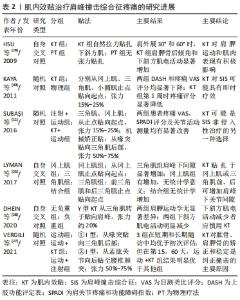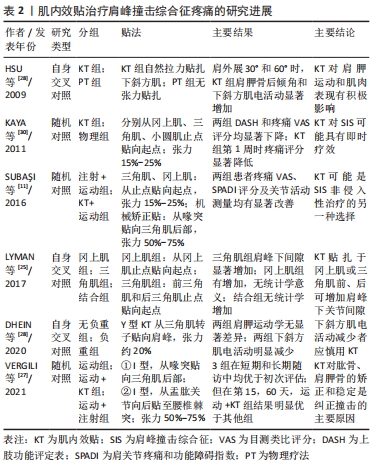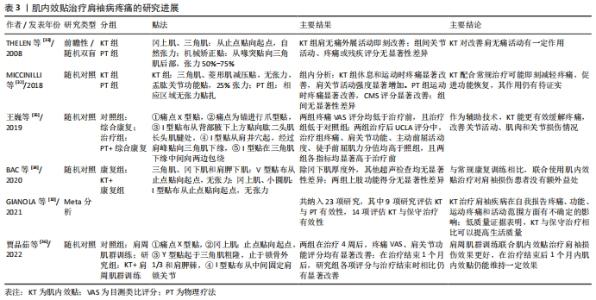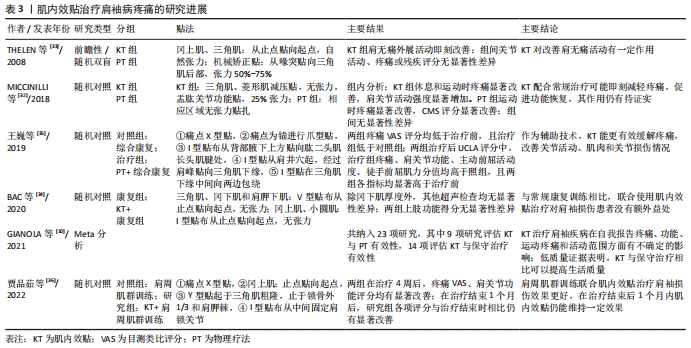Chinese Journal of Tissue Engineering Research ›› 2023, Vol. 27 ›› Issue (14): 2214-2221.doi: 10.12307/2023.160
Previous Articles Next Articles
Kinesiology tape for treating shoulder pain
Liu Kun1, Yin Lulu2, Ma Zheng1, Huang Lihua1, Zhu Ran1, Fang Ping1, Zhang Ye1, Ma Yanhong1
- 1Department of Rehabilitation Medicine, Shanghai Jiao Tong University Affiliated Sixth People’s Hospital, Shanghai 200233, China; 2Rehabilitation Center, the First Affiliated Hospital of Henan University of Traditional Chinese Medicine, Zhengzhou 450000, Henan Province, China
-
Received:2022-04-25Accepted:2022-06-25Online:2023-05-18Published:2022-09-30 -
Contact:Ma Yanhong, Master, Chief physician, Professor, Department of Rehabilitation Medicine, Shanghai Jiao Tong University Affiliated Sixth People’s Hospital, Shanghai 200233, China -
About author:Liu Kun, Master, Department of Rehabilitation Medicine, Shanghai Jiao Tong University Affiliated Sixth People’s Hospital, Shanghai 200233, China -
Supported by:Advanced Appropriate Technology Promotion Project of Shanghai Municipal Health Commission, No. 2019SY013 (to MYH); Hospital-level Project of Shanghai Jiao Tong University Affiliated Sixth People’s Hospital, No. ynhg202016 (to LK)
CLC Number:
Cite this article
Liu Kun, Yin Lulu, Ma Zheng, Huang Lihua, Zhu Ran, Fang Ping, Zhang Ye, Ma Yanhong. Kinesiology tape for treating shoulder pain[J]. Chinese Journal of Tissue Engineering Research, 2023, 27(14): 2214-2221.
share this article
Add to citation manager EndNote|Reference Manager|ProCite|BibTeX|RefWorks

持续性的肌肉骨骼肩痛很常见,肩部问题会严重影响患者的工作能力和其他日常生活活动,如驾驶、穿衣、梳头,甚至吃饭[22]。据报道,引起中老年原发性肩痛的疾病中,最常见的为肩峰撞击、肩袖损伤和肩周炎,分别占比36.08%,22.97%和21.06%,肩周肌肉和肌腱劳损、急慢性滑囊炎以及骨性关节炎等也是引起肩痛的常见疾病[20]。此外,肩关节疼痛在偏瘫患者以及运动人群中也比较常见。大多数肩痛首选保守治疗,常用物理治疗(运动疗法)就能取得良好效果。其中,肌内效贴由于具有黏弹特性,在固定和纠正姿势的同时又不影响贴扎部位的灵活性,近年来在在治疗运动损伤尤其是对肩关节疾病相关疼痛的预防和治疗应用中日益普遍。 2.1 肌内效贴治疗肩峰撞击综合征疼痛的研究进展 肩峰下撞击综合征(Shoulder impingement syndrome,SIS)是肩痛病因中最常见的疾病之一,疼痛常见于肩前面和侧面,通常伴随移动或仰卧体位而加重[23]。肩胛骨运动障碍导致冈上肌出口或肩峰下间隙狭窄的肩部运动学变化是肩峰下撞击综合征最明显的发病机制[24],因此在对肩峰下撞击综合征的物理治疗中,应着重强化向下拖拽肱骨头的肌肉(肩胛下肌、冈下肌、小圆肌),维持肩胛骨平衡稳定的肌肉(斜方肌、前锯肌、菱形肌)以及维持肱骨位置的肌肉(三角肌、胸大肌、背阔肌)。肌内效贴在增加感觉输入的同时,具有缓解疼痛、力学矫正以及增加肩峰下间隙等作用[25],多与常规训练联合应用于肩峰撞击征。 SARACOGLU等[26]在其系统评价中指出,肌内效贴对肩峰下撞击综合征患者可能有即刻疗效。SUBA?I等[11]比较在康复训练的基础上,类固醇注射和肌内效贴对肩峰下撞击综合征患者的疗效,第1条“I”型贴布使用15%-25%的张力从冈上肌止点贴向起点;第2条“Y”型贴布使用15%-25%的张力从三角肌止点贴向止点;第3条“I”型贴布使用50%-75%大张力从喙突贴向三角肌后束,以形成对盂肱关节的机械矫正作用。于随访时发现在康复训练基础上,肌内效贴干预和类固醇注射对肩峰下撞击综合征患者疼痛减轻、关节活动范围扩大以及肩关节残疾指数评分的改善疗效相似,提示肌内效贴有助于肩峰下撞击综合征患者盂肱关节姿势矫正。VERGILI等[27]在盂肱关节矫正的基础上,增加了对肩胛骨位置的矫正和稳定贴扎,使用一条较大张力(50%-75%)的“I”型贴布从盂肱关节向后拉伸至腰椎棘突,使肩胛骨相对胸廓进行下回旋和内收,以再次纠正肩胛胸壁关节,通过稳定肩胛骨并使肱骨头居中,有助于获得正常肩肱节律,消除肩峰下撞击发生的条件,从而减轻疼痛。肌内效贴对肩胛骨运动学和肩周肌电活动影响的研究目前尚存争议,HSU等[28]研究发现,在肩外展30°和60°时,肌内效贴组肩胛骨后倾角和下斜方肌肌电活动显著增加;然而DHEIN等[29]指出,肌内效贴不仅没有改变肩峰下撞击综合征患者肩胛骨运动,同时减少了下斜方肌肌电活动,提示对有下斜方肌肌电活动减少的肩峰下撞击综合征患者应谨慎使用肌内效贴。当肌内效贴单独作为肩峰下撞击综合征治疗时,KAYA等[30]研究发现,虽然单纯肌内效贴治疗与物理治疗对肩峰下撞击综合征患者总体效果相似,但在短期内,肌内效贴治疗对减轻疼痛要更加明显,详见表2。 "


由此可见,对肩峰下撞击综合征患者施加较大张力的肌内效贴力学矫正贴扎,有助于肱骨头回归至肩胛盂中心位置,肩胛骨部分通过机械支撑来辅助前锯肌和下斜方肌的离心收缩,通过向下方和后方推动,两步完成机械纠正盂肱关节,帮助患者获得正常的肩肱节律,从而减轻疼痛,恢复上肢功能。 2.2 肌内效贴治疗肩袖病疼痛的研究进展 肩袖病(Rotator cuff tendinopathy)是一种常见的疾病,发病机制与肩峰下间隙减少、肩关节后囊紧张以及肱骨头内旋不足密切相关,是肩胛骨骼肌肉结构的退化,由肩部负荷过重引起,临床表现为疼痛和关节活动受限,在50岁后的人群中显著增加,一般首选保守治疗[21,31]。目前肌内效贴作为保守疗法在肩袖损伤中的临床疗效存在较大争议。 MICCINILLI等[32]的试验将受试者随机分为真实肌内效贴组和假贴组进行为期2周的干预,探究3种不同的贴布应用结合标准化的康复训练方案对肩袖病患者减轻疼痛和功能恢复的疗效。在其研究中,3种贴布组合贴扎的主要目的在于促进肩关节复位、减少盂肱关节内旋和肩关节后囊紧张:三角肌减压贴扎(无张力)可在运动过程中对三角肌前束和后束提供持续的离心收缩刺激,盂肱关节功能贴扎(25%张力)旨在减轻肩前屈产生的疼痛,菱形肌减压贴扎目的在于使菱形肌收缩以促进肩胛-胸壁运动。MICCINILLI等[32]的试验结果发现真实肌内效贴组在短期内明显减轻患者休息和运动时肩部疼痛,增加肌力以及改善关节运动范围。根据疼痛门控理论,肌内效贴增加感觉刺激,减少痛觉信号传递[33];疼痛的减轻有助于肩部功能改善;而肌力的增加可能是由于肌内效贴对肌肉筋膜的向心牵拉,使得肌肉活动在短期内得到促进作用。然而由于实验组与对照组组间比较没有显著性差异,因此该研究结论还有待更多临床研究进一步证实。BAC等[34]探究肌内效贴联合常规康复训练对肩袖损伤患者的影响,使用3条均不施加拉力的“V”型贴布,第1条从三角肌的止点三角肌粗隆贴向起点肩峰附近,第2条和第3条分别从冈下肌、肩胛下肌的止点贴向起点;另外使用2条均不施加拉力的“I”型贴布,分别从冈上肌、小圆肌的止点贴向起点:旨在观察干预6周后,肌内效贴对肩峰下间隙、肩峰下囊体积、肩袖肌腱厚度以及上肢残疾功能和生活质量的影响。该试验结果发现两组受试者肩峰下撞击均有减少,冈下肌厚度、上肢残疾功能和生活质量均有改善,但两组之间差异并无统计学意义,表明与常规康复训练相比,联合使用肌内效贴治疗对肩袖损伤患者并没有额外的益处。最新发表在《Cochrane》杂志上的一篇Meta分析指出,肌内效贴对肩袖损伤具有很小的疗效或益处[10]。然而王巍等[35]、贾品茹等[36]报道提示,肌内效贴联合常规康复治疗可明显缓解肩袖损伤患者疼痛和关节活动受限,从而提高日常活动能力,且效果可以持续1个月,详见表3。 "


综上所知,在现有的研究中,治疗肩袖损伤患者一般选择无张力的肌内效贴贴扎技术,肌内效贴对减轻肩袖损伤患者疼痛症状具有即刻作用[33],然而对上肢功能和生活质量的提高方面尚存较大争议。由于目前相关文献报道较少,此外较低的研究质量也是引起肌内效贴对肩袖损伤患者疗效的争议原因之一。 2.3 肌内效贴治疗肩周炎疼痛的研究进展 肩周炎(Frozen shoulder)也被称为粘连性肩关节囊炎,是由软组织发炎、充血和纤维化引起肩关节疼痛、僵硬和功能丧失的疾病,常常影响患者基本的日常活动和睡眠[37]。肩周炎以保守治疗为主,而肌内效贴具有增加感觉输入、促进血液循环和减轻疼痛等作用,多与理疗、运动疗法等联合应用于肩周炎患者。 张妍昭等[38]研究肌内效贴联合威伐光干预对肩周围炎患者的临床疗效,其采用自然拉力,针对痛点采用“X”型贴法,针对积液采用2条“灯笼”型贴布进行交叉贴扎,此外对冈上肌、肱二头肌和三角肌分别用“I”型和2条“Y”型贴布从肌肉止点贴向起点,结果发现在治疗后,相较于单纯威伐光治疗组,二者联合应用在疼痛VAS评分、主被动关节活动和肩关节功能CMS评分方面改善更加明显,提示肌内效贴联合威伐光对缓解肩周炎患者症状疗效显著。肌内效贴的机械刺激增加了本体感觉输入,从而抑制疼痛感觉向中枢传递,达到缓解疼痛的作用。邢海清等[39]使用针刀松解联合肌内效贴治疗肩周炎患者,发现二者联合不仅能消除肌肉紧张,有效缓解疼痛,而且有利于肩周软组织修复。肌内效贴的黏弹特性有利于增加皮下空间,同时产生方向性将组织液引流至附近淋巴结,从而达到消肿作用。针刀或手法松解后,肩周组织会再次形成一个“急性创伤”的炎性渗出环境,此时配合肌内效贴可以更快地清除代谢产物,加速肩周软组织功能修复,从而有效治疗肩周炎。此外,研究发现肌内效贴联合常规康复训练、关节松动术、肌肉能量技术以及体外冲击波等对治疗肩周炎患者疼痛和上肢运动功能恢复具有更好的疗效[40-42]。 目前的研究表明,肌内效贴作为一种辅助治疗手段,对减轻肩周炎患者疼痛、改善上肢功能具有积极作用。此外肌内效贴的应用还有助于清除因关节松动术、针刀松解术等带来的炎性渗出和肿胀,帮助肩周环境更快的愈合与恢复。 2.4 肌内效贴治疗过顶运动员肩部疼痛的研究进展 过顶运动中肩胛骨运动模式的改变已被证明与肩痛有关,异常的肩胛骨运动会对软组织造成过度的压力和微损伤,从而引起肩痛,为避免肩部损伤,运动员在进行大量重复性的举肩和过顶运动时需要稳定的肩胛骨和肩肱肌的协调活动[43-44]。既往研究报道,进行过顶运动时,肩胛骨后倾、外旋和上旋是优化肩峰肱骨距离、防止肩峰撞击和肩袖损伤的主要运动[45]。过顶运动员普遍存在肱骨头前移,表现为肩胛骨前倾增加和上旋减少,使运动员盂肱关节活动度减少,从而诱发肩痛,影响肩关节旋转肌力[12]。肌内效贴干预意在通过生物力学的方法,在活动过程中使肩胛骨和盂肱关节重新排列,优化肩峰与肱骨头相对位置和距离,改善肩胛骨后倾、外旋和上旋活动范围,从而提高关节稳定性,减轻损伤和疼痛。 HARPUT等[12]使用肌内效贴对过顶运动员肩胛骨进行矫正贴扎,先令受试者收缩肩胛骨,将第1条“I”型肌内效贴以75%的张力垂直贴扎在肩胛骨的内侧边缘,随后令受试者向后倾斜肩胛骨,以相同的张力从肱骨头前方斜向肩胛骨下缘贴扎第2条“I”型肌内效贴,以纠正肩胛骨位置。该试验通过肌骨超声测量显示肩胛骨贴扎增加了肩肱距离、肩旋转肌力量和内旋运动范围,提示肩胛骨矫正贴扎可以帮助肩胛骨和肱骨回归正确位置,肩峰肱骨头间距的增加可有效防止肩峰下撞击综合征以及疼痛的发生。此外,胸小肌缩短是与肩胛骨运动障碍最相关的软组织变化,在过顶运动中由于重复的肩胛骨牵拉而导致胸小肌张力产生适应性变化。OZER等[46]研究肌内效贴对肩胛骨运动障碍和胸小肌长度的影响,使用75%张力的肌内效贴对过顶运动员盂肱关节进行矫正贴扎,同时对冈上肌和下斜方肌进行促进贴扎,结果发现肌内效贴与传统硬贴的作用一致,肌内效贴在纠正肩胛运动障碍的同时,拉长了胸小肌长度,并且这一作用保持至60-72 h。该团队另一篇报道指出,肌内效贴肩胛骨矫正贴扎有助于改善盂肱关节向内旋转、总旋转范围和后肩关节囊紧张度[47],与HARPUT等[12]的研究结论一致,表明肌内效贴可有效纠正肩胛骨位置,对恢复肩峰肱骨头间距,预防肩峰撞击、肩袖损伤具有积极意义。然而ZANCA等[48]对过顶运动员疲劳后进行肌内效贴干预,结果发现肌内效贴对肩胛骨运动并无显著影响,由于相关文献报道较少,后期可针对肌内效贴对过顶运动员预防疲劳,以及对疲劳状态下肩胛骨运动模式的影响做进一步研究。 肌内效贴可以在不限制关节运动范围的情况下为肩周肌肉和关节提供支撑和稳定性。在过顶运动员中,肌内效贴技术可有效纠正肩胛骨位置和运动模式,在短期内可明显改善肩峰肱骨距离和胸小肌长度,增加肩关节活动范围以及增加肩旋转肌肌肉力量,对肩峰撞击和肩袖损伤的防治具有积极作用;而对肌肉疲劳后肩胛骨运动学的表现还有待进一步证实。 2.5 肌内效贴治疗偏瘫肩痛的研究进展 偏瘫肩痛是脑卒中后最常见的并发症之一,急性脑卒中患者中肩痛的发病率为17%-37%,慢性脑卒中患者约为47%。偏瘫肩痛通常是由痉挛、感知和认知障碍、肩手综合征、肩袖肌肉无力或是由上肢重力影响导致半脱位、肩袖撕裂、肌腱炎症等引起,阻碍患肢的功能和运动恢复,对其日常活动和生活质量产生负面影响[49-50]。与传统非弹性绷带相比,肌内效贴具有提供结构支撑但不限制关节活动的特性,一个恒定的剪切力可以持续作用于皮肤数天,由于这些特性,临床常用它来稳定关节、控制痉挛,通过增加对皮肤机械感受器的刺激来促进肌肉功能,以及通过改善淋巴和血液循环来减少疼痛和炎症[16]。 最新的一篇评价肌内效贴治疗偏瘫肩痛的Meta分析总结道,无论是对急性、亚急性还是慢性脑卒中患者,肌内效贴在减轻疼痛方面都优于假贴、安慰贴或不贴[13],肌内效贴促进肌肉激活,纠正筋膜排列次序,限制关节活动,对于偏瘫肩痛患者减少肩关节半脱位、改善上肢运动功能和日常生活活动能力具有积极作用。另一篇系统评价也指出肌内效贴是一种减少脑卒中患者疼痛和肩半脱位的有益方法[51]。肱二头肌腱鞘炎是偏瘫肩痛的常见原因,HUANG等[2]使用肌肉抑制技术结合空间贴扎技术对偏瘫肩痛患者进行干预,第1条“I”型肌内效贴以15%-25%的张力从冈上肌止点贴向起点,第2条“Y”型肌内效贴起于桡骨粗隆,2条尾端以15%-25%的张力分别沿肱二头肌长、短头延展于三角肌上,第3条“I”型肌内效贴则以50%-75%大张力从肩前部延伸至肩后方,覆盖整个肩锁关节,以稳定肩关节,经过3周干预后发现,患者的肩痛及残疾指数、肩屈曲、外旋、内旋活动明显改善,提示肌内效贴可能是治疗偏瘫肩痛的另一种选择。尽管其作用机制尚不明确,主流解释仍为肌内效贴产生的机械刺激,通过门控机制抑制了脊髓水平的疼痛传导,并增强局部血液和淋巴循环[16]。KALICHMAN等[52]的临床研究指出在短期内肌内效贴对偏瘫患者的肩痛、活动范围或上肢功能并没有影响,然而其纳入样本量较少,只有11名受试者,因此应谨慎看待这一结论。此外,作者认为偏瘫患者不同的肩关节自主活动能力可能对肌内效贴作用有不同的反馈,还需日后进一步研究分析论证。HOCHSPRUNG等[53]发现在短期和中期,肌内效贴或神经肌肉电刺激联合常规治疗对预防偏瘫肩痛并不优于单纯的常规治疗,这可能与偏瘫肩痛的发病机制更加相关。 综上所述,肌内效贴对是否能预防偏瘫肩痛还需更进一步研究,而对改善肩痛、矫正半脱位、提高上肢功能和生活质量有比较理想的疗效,在美国心脏协会/美国中风协会2016年指南中建议对偏瘫肩痛患者进行肌内效贴治疗[54],肌内效贴对疼痛的疗效可能不仅仅是由于其安慰剂效应,未来仍需大量的临床研究对其作用机制加以验证。 2.6 肌内效贴治疗健康及亚健康人群肩部症状的研究进展 1979年国际疼痛学会定义:疼痛是一种“与实际或潜在组织损伤相关的不愉快的感官和情感体验”,是一种复杂的主观感受[55]。在过去20年,年轻成年人因长期低头使用智能手机而导致颈肩痛和上肢不适的发病率明显增加[56-57];长期保持颈部屈曲的姿势会对颈椎和临近组织产生持续负荷,从而导致颈肩部肌肉疲劳、失衡和疼痛[58]。 肌肉疲劳会影响肩关节正常的位置感和运动感[59-60],加强本体感觉输入有助于预防肩部损伤。ZANCA等[61]的交叉对照试验指出肌内效贴对肌肉疲劳后关节位置感的缺失并没有积极作用,作者对受试者分别进行不贴、安慰贴扎和50%张力的肌内效贴贴扎,2条“I”型贴布起于肩锁关节,止于三角肌粗隆,共进行3次干预,每次干预先使肩外展肌肉达到疲劳状态,并在疲劳后进行肩关节外展50°,70°和90°主动复位试验,结果发现不同干预之间并没有显著性差异。AREEUDOMWONG等[62]对24位健康年轻人的右肩分别进行不贴和肌内效贴干预,肌内效贴干预时剪裁成“Y”型贴布,起始段固定于肩峰,2条尾端分别以30%-35%的拉力延展至C7棘突和T3棘突处;令受试者使用智能手机编辑短信30 min,以探究肌内效贴对颈肩不适和右颈竖脊肌、下斜方肌以及前锯肌表面肌电改变的影响;结果发现相较于安慰组,肌内效贴组受试者颈肩不适明显减轻,并延迟了颈部和上躯干肌肉的激活和疲劳。在这项研究中,智能手机的位置相对较低,导致肩部向下、颈部前倾并向手机弯曲,受试者发短信时颈部屈曲保持45°,这可能导致颈部和肩部肌肉比上躯干的中立位置超负荷收缩。已有研究表明,长时间的低负荷激活颈部和上躯干肌肉可引起肌肉疲劳,并对颈椎邻近组织产生压迫力,最终导致颈肩周围区域疼痛[63]。肌肉长时间收缩会降低肌肉活性,增加肌肉疲劳率,这与细胞内代谢物如质子(H+)和乳酸的增加与横桥活动受损有关[64]。肌内效贴的应用使肌肉和皮肤之间产生更大的空隙,从而增加了血液和淋巴循环,使得细胞内的代谢产物可以从肌肉进入血液循环[14]。此外,肌内效贴对皮肤施加的拉力和压力,可能通过刺激皮肤机械感受器而减少贴布区域的疼痛感知[33]。HAN等[9]在随机对照试验中,使用2条拉伸50%张力的“I”型贴布分别从肩峰贴扎至第10胸椎棘突,在贴扎后测量发现肌内效贴明显增加了受试者的胸小肌长度,并明显缩短了仰卧位测量的圆肩姿势和总肩胛距离,表明肌内效贴力学矫正贴扎技术可以对圆肩姿势进行即刻机械矫正。而ALAM等[65]对冈下肌和小圆肌进行促进贴扎,结果发现在不同角速度运动下,肩外旋力量在贴扎前、后并没有显著差异,肌内效贴对关节活动范围的影响也比较有限。 由上可见, 肌内效贴力学矫正贴扎对缓解颈肩部肌肉疲劳和姿势矫正具有积极作用,对增加肌肉力量、关节活动范围和本体感觉的影响较弱。而在另一项躯干伸肌等长收缩抗疲劳实验中,肌内效贴的应用增加了躯干的抗疲劳能力,这可能是由于肌肉在静态等长收缩期间局部血流受阻,导致氧气供应减少和代谢物积累增加,而肌内效贴的应用使得皮肤下空间增加,改善了外周血液和淋巴流动,从而有利于延缓疲劳[66]。然而在动态收缩中,血流并非限制性因素,因此肌内效贴对疲劳缓解并没有产生缓解作用,这可能是ZANCA等并未观察到肌内效贴积极疗效的原因。 2.7 肌内效贴治疗其他肩关节疾病的研究进展 肌内效贴作为一种保守治疗方法广泛应用于多种肌肉骨骼疾病。FRASSANITO等[1]研究肌内效贴对钙化性肌腱病的长期疗效,结果表明与单纯体外冲击波相比,肌内效贴联合体外冲击波治疗似乎改善了肩袖钙化性腱病的恢复,具有更快的治疗效果。ORTA?等[67]将研究聚焦于胸廓出口综合征患者,应用肌内效贴肌肉抑制技术以缓解受压部位紧张的肌肉,使用3条“Y”型和1条“I”型肌内效贴以增加感觉输入,分别以15%-25%张力贴扎于锁骨下肌、胸小肌、肱二头肌以及前斜角肌;结果发现肌内效贴干预可缓解胸廓出口综合征患者的疼痛和感觉异常,并改善上肢功能和生活质量;其作用机制可能类似于“多米诺骨牌”效应,施加在皮肤上的肌内效贴会使皮肤产生褶皱,从而提拉起皮肤,增加皮下间隙,因此肌内效贴在促进筋膜矫正的同时,有利于淋巴和血液循环,还能增加炎症因子的输送,随着水肿和渗出物的消退,伤害感受器感知的压力减少,从而减疼痛。然而心理安慰作用也是不可忽略的因素[14,16,33]。 "

| [1] FRASSANITO P, CAVALIERI C, MAESTRI R, et al. Effectiveness of Extracorporeal Shock Wave Therapy and kinesio taping in calcific tendinopathy of the shoulder: a randomized controlled trial. Eur J Phys Rehabil Med. 2018;54(3):333-340. [2] HUANG Y, CHANG K, LIOU T, et al. Effects of Kinesio taping for stroke patients with hemiplegic shoulder pain: A double-blind, randomized, placebo-controlled study. J Rehabil Med. 2017;49(3):208-215. [3] LIU K, YIN L, MA Z, et al. Effect of Different Kinesio Taping Interventions on the Local Thresholds of Current Perception and Pressure Pain in Healthy Adults. Front Physiol. 2020;11:596159. [4] KAYA MUTLU E, MUSTAFAOGLU R, BIRINCI T, et al. Does Kinesio Taping of the Knee Improve Pain and Functionality in Patients with Knee Osteoarthritis?: A Randomized Controlled Clinical Trial. Am J Phys Med Rehabil. 2017;96(1):25-33. [5] 陈文华,余波.软组织贴扎技术基础与实践:肌内效贴实用诊疗技术图解[M].上海:上海科学技术出版社,2017. [6] LIU K, DUAN Z, CHEN L, et al. Short-Term Effect of Different Taping Methods on Local Skin Temperature in Healthy Adults. Front in Physiol. 2020;11:488. [7] CHANG W, CHEN F, LEE C, et al. Effects of Kinesio Taping versus McConnell Taping for Patellofemoral Pain Syndrome: A Systematic Review and Meta-Analysis. Evid Based Complement Alternat Med. 2015;2015:471208. [8] WANG Y, GU Y, CHEN J, et al. Kinesio taping is superior to other taping methods in ankle functional performance improvement: a systematic review and meta-analysis. Clin Rehabil. 2018;32(11):1472-1481. [9] HAN J, LEE J, YOON C. The mechanical effect of kinesiology tape on rounded shoulder posture in seated male workers: a single-blinded randomized controlled pilot study. Physiother Theory Pract. 2015; 31(2):120-125. [10] GIANOLA S, IANNICELLI V, FASCIO E, et al. Kinesio taping for rotator cuff disease. Cochrane Database Syst Rev. 2021;8(8):CD012720. [11] SUBAŞI V, ÇAKIR T, ARICA Z, et al. Comparison of efficacy of kinesiological taping and subacromial injection therapy in subacromial impingement syndrome. Clin Rheumatol. 2016;35(3):741-746. [12] HARPUT G, GUNEY H, TOPRAK U, et al. Acute effects of scapular Kinesio Taping® on shoulder rotator strength, ROM and acromiohumeral distance in asymptomatic overhead athletes. J Sports Med Phys Fitness. 2017;57(11):1479-1485. [13] DENG P, ZHAO Z, ZHANG S, et al. Effect of kinesio taping on hemiplegic shoulder pain: A systematic review and meta-analysis of randomized controlled trials. Clin Rehabil. 2021;35(3):317-331. [14] KASE K, WALLIS J, KASE T. Clinical Therapeutic Applications of the Kinesio Taping Method Tokyo, Japan: Ken I Kai Co Ltd, 2003. [15] 中国肌内效贴技术临床应用专家共识组 .中国肌内效贴技术临床应用专家共识(2020版)[J].中华物理医学与康复杂志,2021,43(2): 97-108. [16] VERCELLI S, COLOMBO C, TOLOSA F, et al. The effects of kinesio taping on the color intensity of superficial skin hematomas: A pilot study. Phys Ther Sport. 2017;23:156-161. [17] PICAVET H, SCHOUTEN J. Musculoskeletal pain in the Netherlands: prevalences, consequences and risk groups, the DMC(3)-study. Pain. 2003;102(1-2):167-178. [18] BEARD D, REES J, COOK J, et al. Arthroscopic subacromial decompression for subacromial shoulder pain (CSAW): a multicentre, pragmatic, parallel group, placebo-controlled, three-group, randomised surgical trial. Lancet. 2018;391(10118):329-338. [19] WU S, HE L, LI J, et al. Visual display terminal use increases the prevalence and risk of work-related musculoskeletal disorders among Chinese office workers: a cross-sectional study. J Occup Health. 2012; 54(1):34-43. [20] 卫宏图,陆继收,刘艳华,等.中老年人群原发性“肩痛”流行病学调查[J].中国全科医学,2011,14(18):2066-2068. [21] HOPEWELL S, KEENE D, MARIAN I, et al. Progressive exercise compared with best practice advice, with or without corticosteroid injection, for the treatment of patients with rotator cuff disorders (GRASP): a multicentre, pragmatic, 2 × 2 factorial, randomised controlled trial. Lancet. 2021;398(10298):416-428. [22] CHESTER R, KHONDOKER M, SHEPSTONE L, et al. Self-efficacy and risk of persistent shoulder pain: Results of a Classification and Regression Tree (CART) analysis. Br J Sports Med. 2019;53(13):bjsports-2018-099450. [23] LUDEWIG P, COOK T. Alterations in shoulder kinematics and associated muscle activity in people with symptoms of shoulder impingement. Phys Ther. 2000;80(3):276-291. [24] NEER C. Anterior acromioplasty for the chronic impingement syndrome in the shoulder. 1972. J Bone Joint Surg Am. 2005;87(6):1399. [25] LYMAN K, GANGE K, HANSON T, et al. Effects of 3 Different Elastic Therapeutic Taping Methods on the Subacromial Joint Space. J Manipulative Physiol Ther. 2017;40(7):494-500. [26] SARACOGLU I, EMUK Y, TASPINAR F. Does taping in addition to physiotherapy improve the outcomes in subacromial impingement syndrome? A systematic review. Physiother Theory Pract. 2018;34(4): 251-263. [27] VERGILI O, OKTAS B, CANBEYLI I. Comparison of Kinesiotaping, Exercise and Subacromial Injection Treatments on Functionality and Life Quality in Shoulder Impingement Syndrome: A Randomized Controlled Study. Indian J Orthop. 2021;55(1):195-202. [28] HSU Y, CHEN W, LIN H, et al. The effects of taping on scapular kinematics and muscle performance in baseball players with shoulder impingement syndrome. J Electromyogr Kinesiol. 2009;19(6):1092-1099. [29] DHEIN W, WAGNER NETO E, MIRANDA I, et al. Effects of Kinesio Taping on scapular kinematics and electromyographic activity in subjects with shoulder impingement syndrome. J Bodyw Mov Ther. 2020;24(2): 109-117. [30] KAYA E, ZINNUROGLU M, TUGCU I. Kinesio taping compared to physical therapy modalities for the treatment of shoulder impingement syndrome. Clin Rheumatol. 2011;30(2):201-207. [31] OLIVA F, PICCIRILLI E, BOSSA M, et al. I.S.Mu.L.T - Rotator Cuff Tears Guidelines. Muscles Ligaments Tendons. 2015;5(4):227-263. [32] MICCINILLI S, BRAVI M, MORRONE M, et al. A Triple Application of Kinesio Taping Supports Rehabilitation Program for Rotator Cuff Tendinopathy: a Randomized Controlled Trial. Ortop Traumatol Rehabil. 2018;20(6):499-505. [33] THELEN MD, DAUBER JA, STONEMAN PD. The clinical efficacy of kinesio tape for shoulder pain: a randomized, double-blinded, clinical trial. J Orthop Sports Phys Ther. 2008;38(7):389-395. [34] BAC A, WRÓBEL M, OGRODZKA-CIECHANOWICZ K, et al. The influence of the Kinesio Taping on selected ultrasonography measurements, and quality of life in patients with rotator cuff lesions. Sci Rep. 2020; 10(1):18539. [35] 王巍,张锦明.肌内效贴扎应用于肩袖损伤康复治疗的效果观察[J].解放军医学院学报,2019,40(8):776-779+785. [36] 贾品茹,张静,陆博,等.肩周肌群训练联合肌内效贴治疗肩袖损伤的疗效观察[J].中国康复,2022,37(5):289-292. [37] RANGAN A, BREALEY S, KEDING A, et al. Management of adults with primary frozen shoulder in secondary care (UK FROST): a multicentre, pragmatic, three-arm, superiority randomised clinical trial. Lancet (London, England). 2020;396(10256):977-989. [38] 张妍昭,朱凤芝,王刚.肌内效贴联合威伐光治疗肩关节周围炎的临床疗效观察[J].中华物理医学与康复杂志,2021,43(4):347-351. [39] 邢海清,岳瑞卿,叶少奇,等.针刀整体松解联合肌内效贴贴扎治疗肩周炎33例临床观察[J].风湿病与关节炎,2019,8(1):28-31. [40] 曹贤畅.肌内效贴布配合康复训练治疗肩周炎的临床观察[J].中国康复,2017,32(6):462-464. [41] 刘凤艳,刘群,余波,等.体外冲击波结合肌内效贴治疗肩关节周围炎的临床观察[J].中国康复,2016,31(2):98-99. [42] 于洪柱,商健,阎祉圩.肌肉能量技术结合肌内效贴治疗肩周炎的临床疗效分析[J].辽宁体育科技,2021,43(3):59-62+75. [43] KIBLER W, SCIASCIA A. The role of the scapula in preventing and treating shoulder instability. Knee Surg Sports Traumatol Arthrosc. 2016;24(2):390-397. [44] BURKHART S, MORGAN C, KIBLER W. The disabled throwing shoulder: spectrum of pathology Part III: The SICK scapula, scapular dyskinesis, the kinetic chain, and rehabilitation. Arthroscopy. 2003;19(6):641-661. [45] MICHENER LA, MCCLURE PW, KARDUNA AR. Anatomical and biomechanical mechanisms of subacromial impingement syndrome. Clin Biomech. 2003;18(5):369-379. [46] OZER S, KARABAY D, YESILYAPRAK S. Taping to Improve Scapular Dyskinesis, Scapular Upward Rotation, and Pectoralis Minor Length in Overhead Athletes. J Athl Train. 2018;53(11):1063-1070. [47] GULPINAR D, TEKELI OZER S, YESILYAPRAK S. Effects of Rigid and Kinesio Taping on Shoulder Rotation Motions, Posterior Shoulder Tightness, and Posture in Overhead Athletes: A Randomized Controlled Trial. J Sport Rehabil. 2019;28(3):256-265. [48] ZANCA G, GRÜNINGER B, MATTIELLO S. Effects of Kinesio taping on scapular kinematics of overhead athletes following muscle fatigue. J Electromyogr Kinesiol. 2016;29:113-120. [49] RATNASABAPATHY Y, BROAD J, BASKETT J, et al. Shoulder pain in people with a stroke: a population-based study. Clin Rehabil. 2003;17(3):304-311. [50] SACKLEY C, BRITTLE N, PATEL S, et al. The prevalence of joint contractures, pressure sores, painful shoulder, other pain, falls, and depression in the year after a severely disabling stroke. Stroke. 2008; 39(12):3329-3334. [51] RAVICHANDRAN H, JANAKIRAMAN B, SUNDARAM S, et al. Systematic Review on Effectiveness of shoulder taping in Hemiplegia. J Stroke Cerebrovasc Dis. 2019;28(6):1463-1473. [52] KALICHMAN L, FRENKEL-TOLEDO S, VERED E, et al. Effect of kinesio tape application on hemiplegic shoulder pain and motor ability: a pilot study. Int J Rehabil Res. 2016;39(3):272-276. [53] HOCHSPRUNG A, DOMÍNGUEZ-MATITO A, LÓPEZ-HERVÁS A, et al. Short- and medium-term effect of kinesio taping or electrical stimulation in hemiplegic shoulder pain prevention: A randomized controlled pilot trial. NeuroRehabilitation. 2017;41(4):801-810. [54] GITTLER M, DAVIS A. Guidelines for Adult Stroke Rehabilitation and Recovery. JAMA. 2018;319(8):820-821. [55] PEIRS C, SEAL R. Neural circuits for pain: Recent advances and current views. Science (New York, N.Y.). 2016;354(6312):578-584. [56] HAGEN K, LINDE M, HEUCH I, et al. Increasing prevalence of chronic musculoskeletal complaints. A large 11-year follow-up in the general population (HUNT 2 and 3). Pain Med (Malden, Mass.). 2011;12(11): 1657-1666. [57] GUSTAFSSON E, THOMÉE S, GRIMBY-EKMAN A, et al. Texting on mobile phones and musculoskeletal disorders in young adults: A five-year cohort study. Appl Ergon. 2017;58:208-214. [58] SMULDERS M, NADDEO A, CAPPETTI N, et al. Neck posture and muscle activity in a reclined business class aircraft seat watching IFE with and without head support. Appl Ergon. 2019;79:25-37. [59] HARDIN J. The effects of muscle fatigue on shoulder joint position sense. Am J Sports Med. 1998;26(4):605. [60] IIDA N, KANEKO F, AOKI N, et al. The effect of fatigued internal rotator and external rotator muscles of the shoulder on the shoulder position sense. J Electromyogr Kinesiol. 2014;24(1):72-77. [61] ZANCA GG, MATTIELLO SM, KARDUNA AR. Kinesio taping of the deltoid does not reduce fatigue induced deficits in shoulder joint position sense. Clin Biomech (Bristol, Avon). 2015;30(9):903-907. [62] AREEUDOMWONG P, BOOTSAST W, THAPTHIMTHONG C, et al. Effects of kinesio taping on neck-shoulder discomfort and EMG responses during smartphone texting in healthy young adults. Work. 2020;67(4): 847-854. [63] KIM H, KIM J. The relationship between smartphone use and subjective musculoskeletal symptoms and university students. J Phys Ther Sci. 2015;27(3):575-579. [64] WAN J, QIN Z, WANG P, et al. Muscle fatigue: general understanding and treatment. Exp Mol Med. 2017;49(10):e384. [65] ALAM S, MALHOTRA D, MUNJAL J, et al. Immediate effect of Kinesio taping on shoulder muscle strength and range of motion in healthy individuals: A randomised trial. Hong Kong physiother J. 2015;33(2): 80-88. [66] ÁLVAREZ-ÁLVAREZ S, JOSÉ F, RODRÍGUEZ-FERNÁNDEZ A, et al. Effects of Kinesio® Tape in low back muscle fatigue: randomized, controlled, doubled-blinded clinical trial on healthy subjects. J Back Musculoskelet Rehabil. 2014;27(2):203-212. [67] ORTAÇ E, SARPEL T, BENLIDAYI İ. Effects of Kinesio Taping on pain, paresthesia, functional status, and overall health status in patients with symptomatic thoracic outlet syndrome: A single-blind, randomized, placebo-controlled study. Acta Orthop Traumatol Turc. 2020;54(4): 394-401. [68] GOŁĄB A, KULESA-MROWIECKA M, GOŁĄB M. Comparative studies of physical properties of kinesiotapes. Biomed Mater Eng. 2017;28(5): 457-462. [69] AU IPH, FAN PCP, LEE WY, et al. Effects of Kinesio tape in individuals with lateral epicondylitis: A deceptive crossover trial. Physiother Theory Pract. 2017;33(12):914-919. [70] 刘坤.肌内效贴不同贴扎方式对健康人局部电流感觉阈值和疼痛阈值的影响[D].上海:上海体育学院,2020. |
| [1] | Nong Fuxiang, Jiang Zhixiong, Li Yinghao, Xu Wencong, Shi Zhilan, Luo Hui, Zhang Qinglang, Zhong Shuang, Tang Meiwen. Bone cement augmented proximal femoral nail antirotation for type A3.3 intertrochanteric femoral fracturalysis [J]. Chinese Journal of Tissue Engineering Research, 2023, 27(在线): 1-10. |
| [2] | Li Chao, Zhang Peipei, Xu Mengting, Li Linlin, Ding Jiangtao, Liu Xihua, Bi Hongyan. Respiratory training improves morphological changes of the multifidus muscle in patients with chronic nonspecific lower back pain assessed by musculoskeletal ultrasound [J]. Chinese Journal of Tissue Engineering Research, 2023, 27(9): 1417-1421. |
| [3] | Pan Zhongjie, Qin Zhihong, Zheng Tiejun, Ding Xiaofei, Liao Shijie. Targeting of non-coding RNAs in the pathogenesis of the osteonecrosis of the femoral head [J]. Chinese Journal of Tissue Engineering Research, 2023, 27(9): 1441-1447. |
| [4] | Cai Zhihao, Xie Zhaoyong. Femoral neck anteversion measurement assessment: how to establish a unified method and standard [J]. Chinese Journal of Tissue Engineering Research, 2023, 27(9): 1448-1454. |
| [5] | Dang Yi, Du Chengyan, Yao Honglin, Yuan Nenghua, Cao Jin, Xiong Shan, Zhang Dingmei, Wang Xin. Hormonal osteonecrosis and oxidative stress [J]. Chinese Journal of Tissue Engineering Research, 2023, 27(9): 1469-1476. |
| [6] | Zhang Qiming, Bao Sairong, Shan Sharui, Zhong Zhiliang, Liu Chunlong. Effect of deep muscle stimulation on muscle tone and stiffness of erector spinaes in patients with chronic nonspecific low back pain: a digital muscle testing [J]. Chinese Journal of Tissue Engineering Research, 2023, 27(8): 1250-1256. |
| [7] | Wang Ji, Zhang Min, Yang Zhongya, Zhang Long. A review of physical activity intervention in type 2 diabetes mellitus with sarcopenia [J]. Chinese Journal of Tissue Engineering Research, 2023, 27(8): 1272-1277. |
| [8] | Nie Chenchen, Su Kaiqi, Gao Jing, Fan Yongfu, Ruan Xiaodi, Yuan Jie, Duan Zhaoyuan, Feng Xiaodong. The regulatory role of circular RNAs in cerebral ischemia-reperfusion injury [J]. Chinese Journal of Tissue Engineering Research, 2023, 27(8): 1286-1291. |
| [9] | Gao Yu, Han Jiahui, Ge Xin. Immunoinflammatory microenvironment after spinal cord ischemia-reperfusion injury [J]. Chinese Journal of Tissue Engineering Research, 2023, 27(8): 1300-1305. |
| [10] | Guo Tingting, Xie Hong, Xu Guanghua. Finite element analysis of elastic ankle brace performance [J]. Chinese Journal of Tissue Engineering Research, 2023, 27(7): 1031-1037. |
| [11] | Xu Xingxing, Wen Chaoju, Meng Maohua, Wang Qinying, Chen Jingqiao, Dong Qiang. Carbon nanomaterials in oral implant [J]. Chinese Journal of Tissue Engineering Research, 2023, 27(7): 1062-1070. |
| [12] | Li Cheng, Zheng Guoshuang, Kuai Xiandong, Yu Weiting. Alginate scaffold in articular cartilage repair [J]. Chinese Journal of Tissue Engineering Research, 2023, 27(7): 1080-1088. |
| [13] | Chen Shisong, Liu Xiaohong, Xu Zhiyun. Current status and prospects of bioprosthetic heart valves [J]. Chinese Journal of Tissue Engineering Research, 2023, 27(7): 1096-1102. |
| [14] | Lu Di, Zhang Cheng, Duan Rongquan, Liu Zongxiang. Osteoinductive properties of calcium phosphate ceramic bone repair materials [J]. Chinese Journal of Tissue Engineering Research, 2023, 27(7): 1103-1109. |
| [15] | Shi Yehong, Wang Cheng, Chen Shijiu. Early thrombosis and prevention of small-diameter blood vessel prosthesis [J]. Chinese Journal of Tissue Engineering Research, 2023, 27(7): 1110-1116. |
| Viewed | ||||||
|
Full text |
|
|||||
|
Abstract |
|
|||||